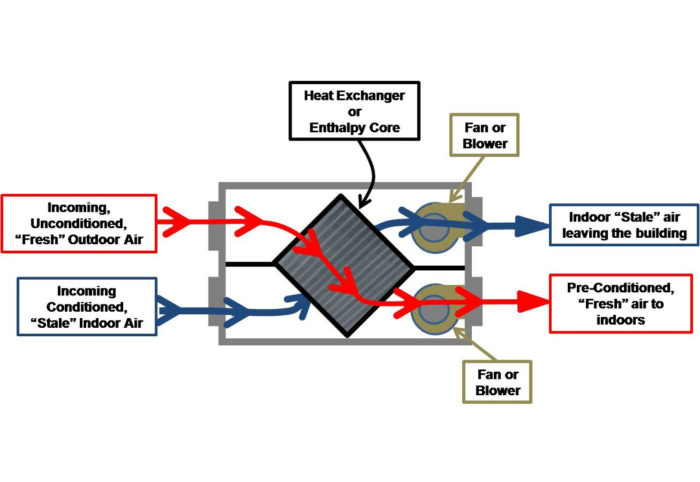Checking out the Benefits of Heat Recovery Ventilation for Energy Effectiveness in Houses
Heat Recovery Ventilation (HRV) systems use home owners a useful approach to enhancing power efficiency. By redeeming warmth from outward bound air, these systems can considerably decrease cooling and heating expenses. Additionally, they give a steady supply of fresh air, improving indoor air quality and comfort levels. As house owners consider lasting alternatives, recognizing the nuances of HRV systems becomes significantly crucial. What variables should one assess prior to making such a financial investment?
Comprehending Heat Recovery Ventilation Equipments

How HRV Improves Indoor Air High Quality

Power Financial Savings: The Economic Benefits of HRV
Making best use of power performance, heat recovery ventilation (HRV) systems provide significant economic benefits for homeowners. By recovering and reusing heat from exhaust air, HRVs noticeably decrease cooling and heating costs. This technology can bring about energy over here savings of approximately 30%, relying on environment and usage patterns. Home owners typically observe minimized energy bills soon after installment, making HRVs an economically wise investment gradually. In addition, several areas offer incentives or rebates for energy-efficient upgrades, additionally improving the financial allure. As energy rates continue to increase, the cost-effectiveness of HRVs comes to be progressively clear. Overall, the incorporation of HRV systems not just advertises power effectiveness but likewise contributes to long-lasting financial savings for families.
The Environmental Influence of Heat Recovery Ventilation
A considerable environmental advantage of heat recovery ventilation (HRV) systems hinges on their capability to decrease general power usage. By recovering heat from exhaust air and moving it to incoming fresh air, HRV systems reduce the demand for energy-intensive heating and cooling approaches. This decrease in power need adds to lower greenhouse gas discharges, as much less nonrenewable fuel source is required to preserve comfy interior temperature levels. In addition, HRV systems boost interior air high quality by effectively exchanging stagnant air with fresh outdoor air, reducing reliance on mechanical cooling systems that can damage the environment. Overall, the application of HRV systems supports sustainable living practices and aligns with international initiatives to combat environment adjustment by advertising power look at here performance in household setups.
Choosing the Right HRV System for Your Home
Just how can home owners ensure they choose the right heat recovery ventilation (HRV) system for their requirements? They should examine their home's size and design, as these variables affect air movement requirements. Next off, reviewing the system's efficiency rankings is crucial, as greater ratings indicate far better performance and energy savings. Home owners must also consider installation and upkeep expenses, contrasting various brand names and models for value. Furthermore, it is very important to assess sound levels, as some systems operate even more quietly than others. Consulting with heating and cooling experts can provide customized referrals based on particular home conditions. Checking out individual evaluations and warranties can assist in making a notified decision, making certain that the selected HRV system properly enhances interior air high quality and energy efficiency.
Regularly Asked Inquiries

Exactly how Typically Should I Clean or Preserve My HRV System?
The regularity of cleaning or maintaining a warmth healing air flow (HRV) system commonly relies on usage and environmental elements. Normally, it is a good idea to perform maintenance every 6 months to assure peak performance and air high quality.

Can HRV Systems Help In Reducing Moisture Levels Inside?
HRV systems can effectively lower indoor moisture levels by exchanging stale, damp air with fresh, drier air from outside. HRV Heat Recovery Ventilation. This process helps keep a well balanced interior atmosphere, boosting comfort and protecting against moisture-related issues
What Is the Life expectancy of a Normal HRV System?
The lifespan of a regular heat recovery ventilation (HRV) system differs, generally lasting between 10 to 15 years. Regular maintenance can expand its efficiency and operational life, guaranteeing peak efficiency throughout its usage duration.
Are There Any Type Of Sound Worry About HRV Solutions?
Sound interest in HRV systems can develop, particularly from follower operation. Nevertheless, many modern units are made to minimize audio degrees, guaranteeing they operate silently while maintaining performance, which deals with potential disruptions in living atmospheres.
Can I Install an HRV System Myself, or Do I Required an Expert?
The individual contemplated whether to mount the heat recovery ventilation (HRV) system personally or work with look what i found a professional. Generally, while DIY installation is possible, competence assurances correct performance and compliance with regional building codes, enhancing system performance.